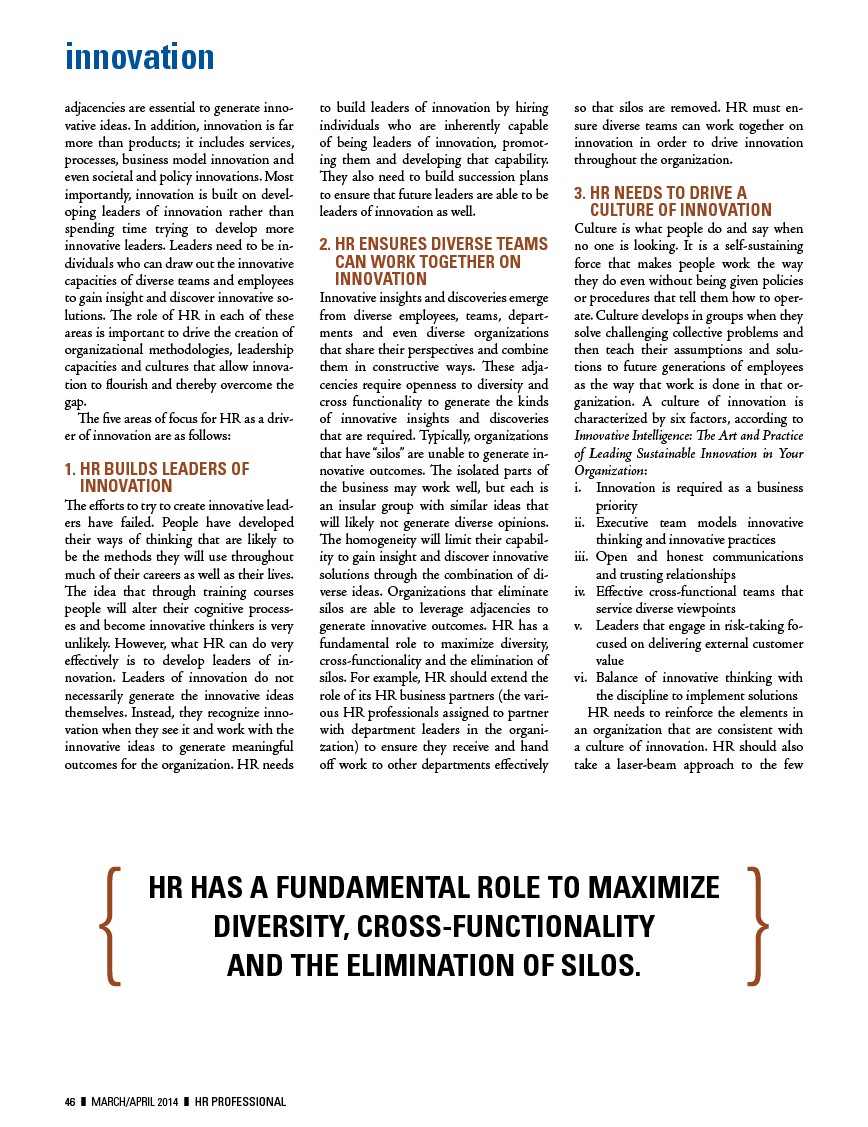
innovation
adjacencies are essential to generate inno-vative
ideas. In addition, innovation is far
more than products; it includes services,
processes, business model innovation and
even societal and policy innovations. Most
importantly, innovation is built on devel-oping
leaders of innovation rather than
spending time trying to develop more
innovative leaders. Leaders need to be in-dividuals
who can draw out the innovative
capacities of diverse teams and employees
to gain insight and discover innovative so-lutions.
The role of HR in each of these
areas is important to drive the creation of
organizational methodologies, leadership
capacities and cultures that allow innova-tion
to flourish and thereby overcome the
gap.
The five areas of focus for HR as a driv-er
of innovation are as follows:
1. HR BUILDS LEADERS OF
INNOVATION
The efforts to try to create innovative lead-ers
have failed. People have developed
their ways of thinking that are likely to
be the methods they will use throughout
much of their careers as well as their lives.
The idea that through training courses
people will alter their cognitive process-es
and become innovative thinkers is very
unlikely. However, what HR can do very
effectively is to develop leaders of in-novation.
Leaders of innovation do not
necessarily generate the innovative ideas
themselves. Instead, they recognize inno-vation
when they see it and work with the
innovative ideas to generate meaningful
outcomes for the organization. HR needs
to build leaders of innovation by hiring
individuals who are inherently capable
of being leaders of innovation, promot-ing
them and developing that capability.
They also need to build succession plans
to ensure that future leaders are able to be
leaders of innovation as well.
2. HR ENSURES DIVERSE TEAMS
CAN WORK TOGETHER ON
INNOVATION
Innovative insights and discoveries emerge
from diverse employees, teams, depart-ments
and even diverse organizations
that share their perspectives and combine
them in constructive ways. These adja-cencies
require openness to diversity and
cross functionality to generate the kinds
of innovative insights and discoveries
that are required. Typically, organizations
that have “silos” are unable to generate in-novative
outcomes. The isolated parts of
the business may work well, but each is
an insular group with similar ideas that
will likely not generate diverse opinions.
The homogeneity will limit their capabil-ity
to gain insight and discover innovative
solutions through the combination of di-verse
ideas. Organizations that eliminate
silos are able to leverage adjacencies to
generate innovative outcomes. HR has a
fundamental role to maximize diversity,
cross-functionality and the elimination of
silos. For example, HR should extend the
role of its HR business partners (the vari-ous
HR professionals assigned to partner
with department leaders in the organi-zation)
to ensure they receive and hand
off work to other departments effectively
so that silos are removed. HR must en-sure
diverse teams can work together on
innovation in order to drive innovation
throughout the organization.
3. HR NEEDS TO DRIVE A
CULTURE OF INNOVATION
Culture is what people do and say when
no one is looking. It is a self-sustaining
force that makes people work the way
they do even without being given policies
or procedures that tell them how to oper-ate.
Culture develops in groups when they
solve challenging collective problems and
then teach their assumptions and solu-tions
to future generations of employees
as the way that work is done in that or-ganization.
A culture of innovation is
characterized by six factors, according to
Innovative Intelligence: The Art and Practice
of Leading Sustainable Innovation in Your
Organization:
i. Innovation is required as a business
priority
ii. Executive team models innovative
thinking and innovative practices
iii. Open and honest communications
and trusting relationships
iv. Effective cross-functional teams that
service diverse viewpoints
v. Leaders that engage in risk-taking fo-cused
on delivering external customer
value
vi. Balance of innovative thinking with
the discipline to implement solutions
HR needs to reinforce the elements in
an organization that are consistent with
a culture of innovation. HR should also
take a laser-beam approach to the few
HR HAS A FUNDAMENTAL ROLE TO MAXIMIZE
DIVERSITY, CROSS-FUNCTIONALITY
AND THE ELIMINATION OF SILOS.
46 ❚ MARCH/APRIL 2014 ❚ HR PROFESSIONAL